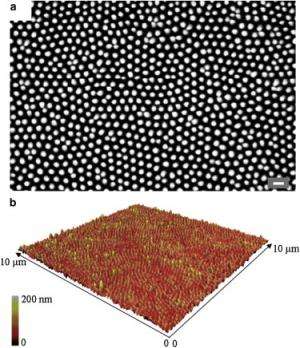March 6, 2013 report
Researchers find cicada wing structure able to kill bacteria on contact (w/ video)

(Phys.org) —A combined team of researchers from Spain and Australia has discovered what they claim is the first known instance of a biomaterial that can kill bacteria on contact based only its physical surface structure. In their paper published in Biophysical Journal, the team describes how they found that clanger cicadas have nanoscale sized pillars on their wings that trap and slowly kill bacteria by pulling their cells apart.
Under a microscope, the team reports, the wings of the clanger cicada show a landscape hostile to bacteria—vast arrays of blunted spikes. When bacteria land on the spikes, they don't pop, as might be expected, instead, they stick and are slowly torn apart as their cell skin descends to the wing surface between the spikes. It works because at least some bacteria have elastic skin.
It's similar to a water balloon landing on a bed of blunt nails. The nails aren't sharp enough to pierce the balloon's skin, but over time, as the weight of the water inside the balloon pushes the skin between the spikes, causing it to stretch, tears eventually develop, causing the balloon to deflate, or in the case of the bacteria on the cicada's wing, death.
To make sure they understood what was actually going on with the cicada's wings and the bacteria that landed on them, the researchers cooked some bacteria in a microwave to cause different degrees of elasticity in their skin. Those specimens were then dropped onto a cicada wing surface to see what would happen—unsurprisingly, those that were more elastic were torn apart, while those that were more rigid, were not. It's the first time anyone's seen a living organism fend off bacteria using nothing more than the shape of their biomaterial.
Such a finding is of course exciting to those that study infectious microorganisms, and perhaps to everyone else as it may lead to the development of materials that could be used to perform the same action for us, though not as an extension of our own bodies of course. Coverings could be made for countertops, doorknobs or hand rails, etc., to kill bacteria and/or viruses on contact without having to resort to polluting bioagents.
Additional videos: www.youtube.com/watch?v=KSdMYX4gqp8 and www.youtube.com/watch?v=eIwj_ThMf4Q
More information: Biophysical Model of Bacterial Cell Interactions with Nanopatterned Cicada Wing Surfaces, Biophysical Journal, Volume 104, Issue 4, 835-840, 19 February 2013, doi:10.1016/j.bpj.2012.12.046
Abstract
The nanopattern on the surface of Clanger cicada (Psaltoda claripennis) wings represents the first example of a new class of biomaterials that can kill bacteria on contact based solely on their physical surface structure. The wings provide a model for the development of novel functional surfaces that possess an increased resistance to bacterial contamination and infection. We propose a biophysical model of the interactions between bacterial cells and cicada wing surface structures, and show that mechanical properties, in particular cell rigidity, are key factors in determining bacterial resistance/sensitivity to the bactericidal nature of the wing surface. We confirmed this experimentally by decreasing the rigidity of surface-resistant strains through microwave irradiation of the cells, which renders them susceptible to the wing effects. Our findings demonstrate the potential benefits of incorporating cicada wing nanopatterns into the design of antibacterial nanomaterials.
Journal information: Biophysical Journal
© 2013 Phys.org


















